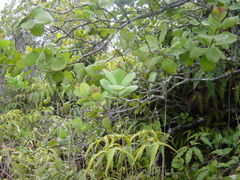Santalum
| Features: | ✓ | evergreen |
|---|
|
Santalum > |
L. > |
If this plant info box on watering; zones; height; etc. is mostly empty you can click on the edit tab and fill in the blanks!
Santalum is a genus of woody flowering plants, the most well known and commercially valuable of which is the Indian Sandalwood tree, S. album. Members of the genus are trees or shrubs. Most are root parasites which photosynthesize their own food but tap the roots of other species for water and inorganic nutrients. Several species, most notably S. album, produce highly aromatic wood, used for scents and perfumes and for herbal medicine. There are approximately 25 species, ranging across the Indomalaya, Australasia, and Oceania ecozones, from India through Malesia to the Pacific Islands, as far as [[Hawaii|HawaiTemplate:Okinai]] and the Juan Fernández Islands off the coast of South America.
Indian Sandalwood (S. album) is found in the tropical dry deciduous forests of India, the Lesser Sunda Islands of Indonesia, and Arnhem Land of northern Australia. It is the only species found on the Asian mainland, and may have been introduced to India from the Lesser Sundas centuries ago. Indian Sandalwood has been stripped from most of India's forests, and is now rare in the wild. Five species, including S. album, are native to Australia. S. acuminatum, known as the sweet quandong or native peach, produces a shiny bright red fruit used increasingly in Australia for jams, jellies, chutneys and in pies. Four species, commonly called Template:Okinailiahi, are endemic to HawaiTemplate:Okinai. S. fernandezianum, endemic to the Juan Fernández Islands off the coast of Chile, was overexploited for its aromatic wood, and may now be extinct.
Read about Santalum in the Standard Cyclopedia of Horticulture
|
|---|
|
Santalum (from the Persian Chandal which in turn is derived from the Sanscrit Chandana, the name of the tree). Santalaceae. Evergreen glabrous trees or shrubs, and one species, S. album, yields the sandalwood: lvs. opposite, rarely alternate, coriaceous: fls. axillary or in terminal trichotomous paniculate cymes, dioecious; perianth campanulate or ovoid, lobes 4, rarely 5, valvate with a tuft of hair on their face; stamens 5-4, short; disk of scales between the stamens; ovary at first free, finally half-inferior: drupe subglobose.—About 10 species, India, Malaya, Austral, and Pacific Islands. Plants more or less parasitic. CH
|
Cultivation
There are numerous initial challenges to cultivating Santalum, not only due to its germination and growth needs, but also the amount of growing time required for the tree to properly mature. Germination of Santalum seeds is not completely understood. Seeds cannot be effectively stored, and must be planted upon harvesting them from a fruiting tree. Even in doing this, the seeds may not germinate. As such, growing saplings can be quite labour intensive.
Furthermore, although Santalum trees photosynthesizes on their own, the trees are semi-parasitic, with roots that seek out and tap the root systems of surrounding trees for water and nutrients. As such each sapling are usually grown together next to four to five host trees. Pruning of host trees are also needed at times since Santalum trees require much sunlight for growth.
Propagation
Pests and diseases
becomes more resistant to environmental stresses, pest, and disease as it matures.
Species
- S. acuminatum A.DC. — Desert Quandong, Sweet Quandong, Native Peach (Australia)
- S. album L. — Indian Sandalwood, White Sandalwood, Chandana (India, Indonesia, northern Australia)
- S. austrocaledonicum Vieill. (New Caledonia, Vanuatu)[1]
- S. ellipticum Gaudich. — Template:OkinaIliahialoTemplate:Okinae, Coast Sandalwood ([[Hawaii|HawaiTemplate:Okinai]])[2]
- S. fernandezianum Phil. (Juan Fernández Islands)
- S. freycinetianum Gaudich. — Template:OkinaIliahi (HawaiTemplate:Okinai)[3][4]
- S. haleakalae Hillebr. — Template:OkinaIliahi (HawaiTemplate:Okinai)
- S. lanceolatum R.Br. — Northern Sandalwood (Australia)
- S. macgregorii F.Muell (Papua New Guinea, Indonesia)
- S. murrayanum C.A.Gardner — Bitter Quandong (Australia)
- S. obtusifolium (Australia)
- S. paniculatum Hook. & Arn. — Template:OkinaIliahi (HawaiTemplate:Okinai)
- S. salicifolium — Willowleaf Sandalwood
- S. spicatum (R.Br.) A.DC. — Australian sandalwood (Australia)
- S. yasi Seem. - Yasi (Fiji, Niue, Tonga)[5]
Gallery
References
- ↑ "Santalum austrocaledonicum Vieill.". Germplasm Resources Information Network. United States Department of Agriculture (2006-05-12). Retrieved on 2009-04-05.
- ↑ Template:Cite paper
- ↑ Template:Cite paper
- ↑ Allen, James A. (2003-01-01). "Santalum freycinetianum Gaudich." (PDF). Tropical Tree Seed Manual. Reforestation, Nurseries & Genetics Resources. Retrieved on 2009-03-01.
- ↑ "Santalum yasi Seem.". Germplasm Resources Information Network. United States Department of Agriculture (1999-08-19). Retrieved on 2009-04-05.
- Standard Cyclopedia of Horticulture, by L. H. Bailey, MacMillan Co., 1963
External links
- w:Santalum. Some of the material on this page may be from Wikipedia, under the Creative Commons license.
- Santalum QR Code (Size 50, 100, 200, 500)

